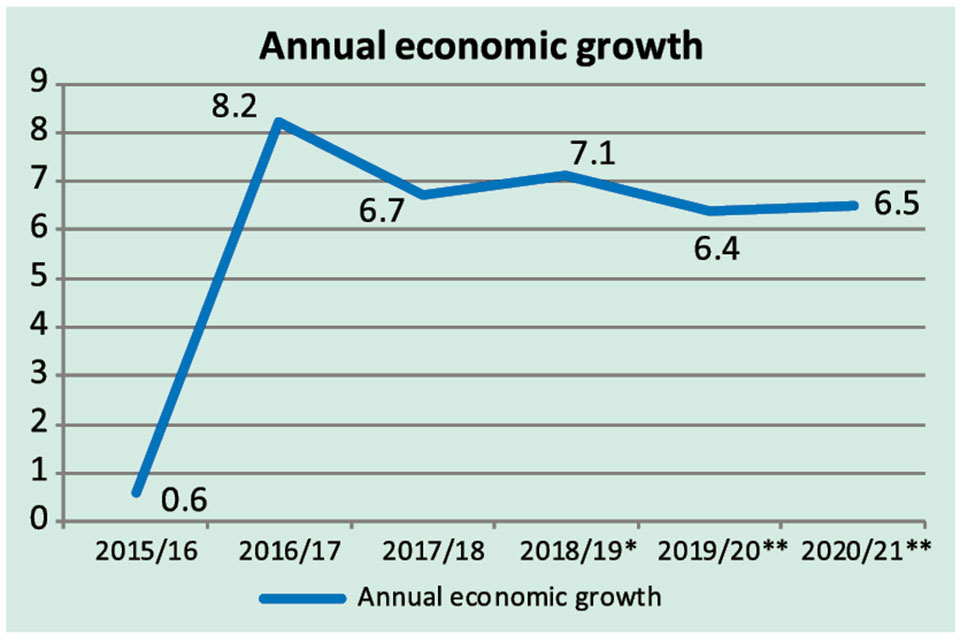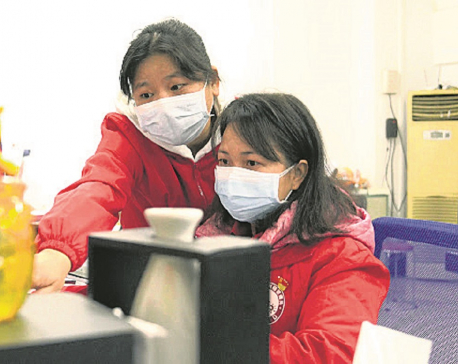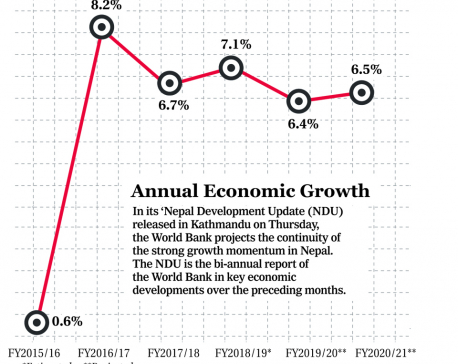
OR
Is the 8.5 pc growth target achievable?
Published On: February 23, 2020 08:39 AM NPT By: Sagar Ghimire | @sagarghi

External shocks including the coronavirus outbreak make even maintaining last year’s growth momentum challenging
KATHMANDU, Feb 23: Upbeat with the economic growth rate in the last three years which remained higher than an average of more than six per cent, the government has set its sight on a growth rate of 8.5 per cent in the current fiscal year 2019/20.
However, the recent developments, particularly the external factors, are likely to dampen the growth momentum in the current fiscal year.
These headwinds have not only made the government’s ‘ambitious’ growth target look improbable but pose challenges even to maintain the same pace of the growth that the country observed in the last three fiscal years. Nepal’s economy has grown by above six per cent in the last three fiscal years with the growth rate reaching 7.1 percent in the last fiscal year 2018/19. The economic recovery from a tepid growth of 4.1 percent between fiscal year 2007/08 and FY2015/16 has remained robust.
But some of the recent external shocks have now clouded the economic outlook of the country.
The recent Coronavirus outbreak in China, economic slowdown in India and sluggish remittance growth are all going to negatively impact the economy of Nepal. Economists say that these factors will hit the country’s economic growth.
As the economic growth was expected to be driven by the service sector, the recent Coronavirus outbreak dealt a blow to the tourism industry of Nepal. Not only the tourist arrivals from China — the second largest tourism market for Nepal — are slumping, there is a risk that many international travelers could cancel their trips to Asia which will directly hit the tourism sector of Nepal.
Similarly, the Coronavirus outbreak is also impacting some of the country’s mega projects that are going to be built by Chinese contractors or rely on Chinese supply. The ongoing construction of two national pride projects — Gautam Buddha International Airport (GBIA) and Upper Tamakoshi Hydropower Project — is facing delays due to the lack of Chinese workers, say project officials.
“At a time when there is already slackness in our economy in recent months, these external risks are going to further adversely impact our growth momentum,” Dilli Raj Khanal, an economist, told Republica.
“While it is still uncertain whether the Coronavirus outbreak will have a long-term impact, the current trend indicates a setback not only to the global economy but also to our growth momentum,” said Khanal, pointing out to tourism, trade and internal multiplier effects of the virus.
While the Coronavirus appears as the latest dampener of the economic recovery of the country, there were already some domestic factors that were posing challenge for the government to achieve its 8.5 percent ‘ambitious’ growth target in the current fiscal year.
For example, the government has not been able to boost spending, particularly capital expenditure, even in the current fiscal year. Rather, the government has revised down the capital expenditure plan to Rs 326.81 billion through the mid-term review against the allocated amount of Rs 408 billion. On the other hand, the private sector also looks less confident in pouring their investment in the country as evident in the fall in the amount of the foreign direct investment in recent years. Even the post-earthquake reconstruction drive which was one of the drivers of growth for last three years is winding down.
Similarly, paddy output fell to 5.55 million tons in the current fiscal year from the record high production of 5.61 million tons in the last Fiscal Year 2018/19. As paddy accounts for nearly one-fifth of the agricultural GDP in the country, decline in paddy output could also impact the growth.
While multilateral organizations like the World Bank, Asian Development Bank and International Monetary Fund have projected a growth at the range of 6 to 6.4 per cent, their forecasts which came a few months ago have not factored in the impact of the Coronavirus outbreak in the economy.
A mission of the IMF that visited Nepal last month has concluded that the recent slowdown of the Indian economy, fall in the agricultural production and sluggishness in remittance inflow could moderate the growth of Nepal in the current fiscal year 2019/20 to six per cent. These institutions are likely to revise down their Nepal projections in their next updated forecasts as damages of the Coronavirus epidemic continue to increase.
However, there are some who are still hopeful about the recovery. “If the government comes up with a fiscal stimulus to offset these recurring external adversities, there is possibility that we could have a strong growth,” said Nara Bahadur Thapa, a former chief of the Research Department of Nepal Rastra Bank. “Also, the spending by the local governments will also drive the growth,” he added.
You May Like This

Don’t stigmatize China
When the news emerged that a Chinese doctor, who had warned his colleagues about an emerging virus, was reprimanded by... Read More...

Nepali women married to Chinese nationals reluctant to return back to Nepal
BEIJING, Feb 8: The government is preparing to evacuate Nepali citizens living in China in the wake of the coronavirus... Read More...

WB projects economy to grow at 6.4%
KATHMANDU, Dec 13: Nepal’s economy is expected to grow by 6.4% in the current fiscal year – FY2019/20, according to the... Read More...







Just In
- NRB to provide collateral-free loans to foreign employment seekers
- NEB to publish Grade 12 results next week
- Body handover begins; Relatives remain dissatisfied with insurance, compensation amount
- NC defers its plan to join Koshi govt
- NRB to review microfinance loan interest rate
- 134 dead in floods and landslides since onset of monsoon this year
- Mahakali Irrigation Project sees only 22 percent physical progress in 18 years
- Singapore now holds world's most powerful passport; Nepal stays at 98th











Leave A Comment